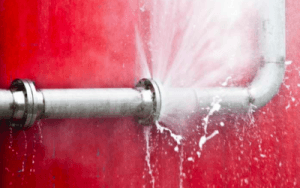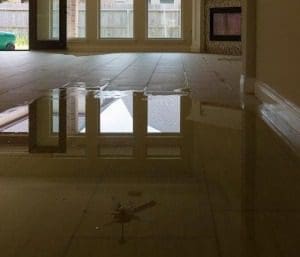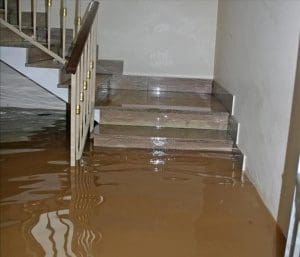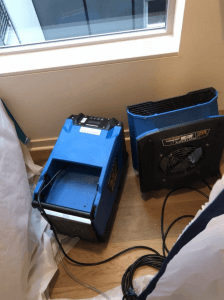Quick Summary of The Ultimate Guide To Water Damage Restoration
- The 3 Categories of Water Contamination
- The 4 Classes of Water Damage
- The 3 Main Types of Water Removal Equipment
- 3 Common Water Damage Situations
“I love water damage!” said no one, ever. If you’ve experienced it, you know it’s awful. It doesn’t matter if it’s minor enough to take care of on your own or major enough to require a restoration company. It’s awful no matter what. One thing, though, is certain. The more educated you are on water damage removal, the smoother your restoration process will be. Even if you’ve hired a water removal company to take care of it. The more you know, the more accurate your decisions will be now and in the future.
This article is a comprehensive guide that goes over all the basics of water damage removal. Let’s get started!
The Three Categories of Water Damage
Perhaps the most important aspect of treating water damage is knowing how contaminated the unwanted water is. Where restoration is concerned, there are three categories water damage contamination.
Category 1

Refers to water that is clean enough that a person could drink it. Water in Category 1 is completely or near-completely uncontaminated. This means that if you inhaled it, touched it, or ingested it, there would be no negative side effects. If the unwanted water came from a fresh water source like rainwater or a sprinkler system, it’s Category 1.
The only risks on a job like this are dangerous surroundings. Like if electrical sources are close by; power lines, for examples. But the water itself poses no danger to workers.
Category 2

Refers to what we call gray water. This is water that’s definitely not safe for consumption and, in most cases, to touch. It has unsafe biological matter and high microorganism levels. Water that contains chemicals or urine, for example, are Category 2.
The water obviously poses a risk here, unlike Category 1. Onsite specialists should wear equipment that protects their bodies; coveralls, gloves, boots.
Category 3

Refers to extremely contaminated water that has clear potential to be life-threatening. We call this black water. Pathogens, hazardous toxins, heavy metals, and/or pesticides are found in Category 3. Examples can include natural waterway overflow and raw sewage.
Depending on the severity of a Category 3 situation, full-body protection may be necessary for workers. Special containers are often used to house and later dispose of contaminated materials. Anyone onsite should be extremely aware of their surroundings to avoid injury or accident.
This Is Also Important
Contaminated water that begins in one category can jump to a higher one if remediation isn’t prompt. For example, pathogens and bacteria can quickly develop and breed in standing water. Also, what begins as spores rapidly turns to mold if left unattended for too long. In other words, minor health risks can speedily escalate to major health risks with inadequate attention.
The Four Classes of Water Damage
Independent of contamination, there are four general classes of water damage. They are as follows.
Class 1
Refers to water damage involving low saturation. For example, when the surface covered in water is a tiled floor, sealed concrete, or other non-porous surface. Typically, a Class 1 circumstance doesn’t require much work (if any) after water removal.
Class 2
Refers to water damage involving material that is more porous, like surfaces made from wood or gypsum board. In a Class 2 situation, a lot more water (compared to Class 1) is absorbed into the surface. This means more damage. A Class 2 job usually requires a lot of post-remediation efforts to repair the affected areas. This means that after the water is removed and surfaces are dried, serious repair or replacement work will need to be done.
Class 3
Refers to water damage involving surfaces that are highly porous, yielding significant (sometimes irreplaceable) damage. This class also refers to any situation involving massive amounts of water. In a Class 3 circumstance, a restoration company would need to “pull out all the stops” to eliminate the unwanted water. Examples of a Class 3 situation include flooded underground areas, saturated upholstery and carpets, or a building that is thoroughly soaked.
Class 4
Class 4 is similar to Class 3 with two differences. Class 4 involves: (1) flooding in areas that are hard to get to in addition to being highly porous. And (2) when highly contaminated water (like sewage) has been absorbed into the walls or floors. These situations usually require special equipment, take longer, and are more costly. Which is why these circumstances are in a class of their own.
Remember This
Assessing the contamination category and damage class are the first two things a restoration company will do. They’ll begin the remediation process once these diagnoses are made. There’s a reason these classes and categories exist. It’s because depending on the circumstance, particular equipment and techniques are called for.
The 3 Main Types of Water Removal Equipment
In almost every water damage restoration job, there are three main types of equipment used. Air movers, dehumidifiers, and air scrubbers.
Air Movers

These are drying machines that do what you would suspect based on their name. They blow air throughout the affected room or area. The circulating air helps the area to dry faster. Air movers come in different sizes, increasing in power the larger they are. When you purchase one, you’ll see that its capacity is measured by how much air is moved per minute per cubic feet.
You might be thinking, “So…you’re talking about fans. Why not just call it a fan?” Commercial air movers used by professionals are different than fans. They have higher functionality than traditional household fans and are considerably stronger. Hence, they’re called air movers. Not fans.
Dehumidifiers
![Dehumidifiers PureDry Restoration
Water Damage Restoration [city] WA](https://puredry.com/wp-content/uploads/2019/09/water-damage-restoration-300x225.jpg)
These are machines that remove moisture from the air. They are designed quite differently compared to machines meant to remove water from a surface. Large amounts of moisture left in the air lead to mildew and mold growth. Dehumidifiers work to eliminate that possibility. Like air movers, they come in different shapes and sizes. In a 24 hour period, a standard dehumidifier unit can rid the air of around 150 pints of water. Bigger, industrial dehumidifiers (called low grain refrigerants) can remove even more, some over 200 pints per 24 hours.
Air Scrubbers
![Air Scrubber Pure Dry Restoration
Water Damage Restoration [city] WA](https://puredry.com/wp-content/uploads/2019/09/IMG_4290-1024x1023-300x300.jpg)
These are different from dehumidifiers in that they clean particles and odors out of the air rather than water. Though these are often used for water damage restoration, they are used even more frequently for fire damage restoration. They clean the air of lingering smoke particles. When used for water damage, it’s primarily for the purpose of ridding the air of smells. These smells are almost always caused by mold and mildew.
Air scrubbers come in two varieties: dry and wet. The difference is in the type of filters inside the machine. We air scrubbers use wet filters and dry air scrubbers use ionic purifiers.
3 Common Water Damage Situations
Now you’ve got some knowledge under your belt. Let’s look at 3 common scenarios we encounter in the water damage restoration industry. We’ll explain how each one is dealt with.
Hot Water Tank Bursts – Category 1 / Class 1
The older a hot water tank is, the higher the risk of it bursting. This is one of the most common reasons people call water damage restoration companies. It often happens in commercial buildings/complexes. Let’s say a building’s mechanical room has a couple hundred gallons of loose fresh water because of the burst tank. Let’s also say that the building houses a woodworking business. And that 75 gallons of water found its way into the main workshop with sawdust everywhere.
In this case, the first thing we’ll do is look for any non-water-related hazard like electrical cords, etc. This will almost always involve turning off the main power supply, or at least certain areas. Then we’ll shutoff the water valve. We’ll contact a plumber to remove and replace the broken water tank. The plumber will check for any blockages that may have assisted the incident in any way. We would then proceed to remove any wet material that can or should be disposed of.
Time to remove the water. With only a couple hundred gallons, we’ll start by using industrial sponges and mops. For ventilation, all windows and doors are opened. Depending on the room’s size, 1-2 air movers will be utilized so we can finish drying the floor. The moisture levels in the air are kept down by using a dehumidifier of adequate size. Rubber boots and gloves are the only protecting we need in this situation.
Failed Sump-Pump – Category 2 / Class 2
Sump-pumps are common in restaurants due to the large amount of organic waste, oil, and grease they dispose of. And a lot of times these drainage areas are located in small crawl spaces and basements. Once material enters the drainage system, it makes its way to the sewer by way of a pump system. Let’s say the sump-pump in a restaurant stopped working and no one noticed for days. Because the incident took place in a crawl space, mold had time to develop in 6 inches of water.
As expected, the first thing we do is check for external hazards mainly involving electricity. We check for proper lighting and access since the affected area is a crawl space. The water is shut off along with any isolated electrical areas. Windows (if any) are opened for ventilation. We would likely be able to remove all standing water with two air movers. And we only needed a small dehumidifier because the space was also small.
Because the incident hadn’t been caught for days, there was mildew and mold. We use an air scrubber to address that. Once we succeed in dehumidifying and drying everything, an anti-fungal solution is applied to every surface in the restaurant. This is because restaurants have strict health codes they must adhere too. Because this was a Class 2 contamination incident, workers used coveralls, gloves, boots, filtered respirators, and eye protection.
Sewage Flood – Category 2 / Class 4
Let’s say a warehouse with porous floors was flooded with a foot of sewage-infested water caused by heavy rainfall. The rain raised the river’s water level which blocked a sewage pipe. In addition, the remnants of tiny oil spills were involved in the flow. This caused brown water to enter the warehouse.
Hazards are identified. An assessment is made regarding the effects of water damage on the building’s structural integrity. Water flow into the building is contained with ditching since we know the water won’t abate naturally anytime soon. Standing water is removed with sponges, mops, and pumps. Ventilation is achieved by opening everything we can that leads outside. We use 4 large air movers because of the severity of the incident and because of the large space.
Portable heaters are brought in to help with the monumental task of drying the space. We incorporate the existing HVAC system in the building to help with drying.
We don’t use dehumidifiers in this case. We know they’ll be ineffective because of the large size of the affected area. Workers need to wear maximum protection on this job due to the oil spills, sewage, and hazardous pathogens in play. All contained material is disposed of in accordance with industry standards.
Water Damage Restoration (The Ultimate Guide) – Conclusion
In most cases, professionals should be notified in the event of water damage. Whatever your situation, give us at PUREDRY™ a call and we’ll help you assess it over the phone as best we can. Do not attempt restoration yourself if your incident involves unclean water. It’s best to contact a water damage restoration company no matter what and go from there. We’re here to help!
Note: restoration companies like PureDry are required by law to follow industry regulations. Companies only receive accreditation when they agree to follow the ethical and safe principles set forth by the ANSI and IICRC. These organizations provide a foundation for restoration companies to operate on. They don’t dictate exact processes.
We at PureDry Restoration are certified in both the ANSI and the IIRC! We take our certifications very seriously and work very hard to make sure we know all industry guidelines and protocols.
IICRC = International Cleaning and Restoration Certification
As a premier restoration company, we service the Seattle, WA area, including:
- Alderwood Manor WA
- Arlington WA
- Bellevue WA
- Bothell WA
- Cottage Lake WA
- Echo Lake WA
- Edmonds WA
- Everett WA
- Issaquah WA
- Kenmore WA
- Kent WA
- King County WA
- Kirkland WA
- Lake Forest Park WA
- Lake Stevens WA
- Lynnwood WA
- Martha Lake WA
- Marysville WA
- Mill Creek WA
- Monroe WA
- Mountlake Terrace WA
- Mukilteo WA
- North Creek WA
- Redmond WA
- Sammamish WA
- Seattle WA
- Shoreline WA
- Snohomish WA
- Snohomish County WA
- Stanwood WA
- Stimson Crossing WA
- Three Lakes WA
- Tulalip Bay WA
- Woodinville WA
Only trained professionals with the right equipment should handle water removal.
Our team of professionally certified Water Damage Experts have years of experience resolving various sewage cleanup and repair problems.
Call PureDry® Restoration 24 hours a day, seven days a week for immediate water damage relief.
We are never closed, and you will always be connected to a live person!
We will be to you in 60 minutes or less from the time the call is placed.
